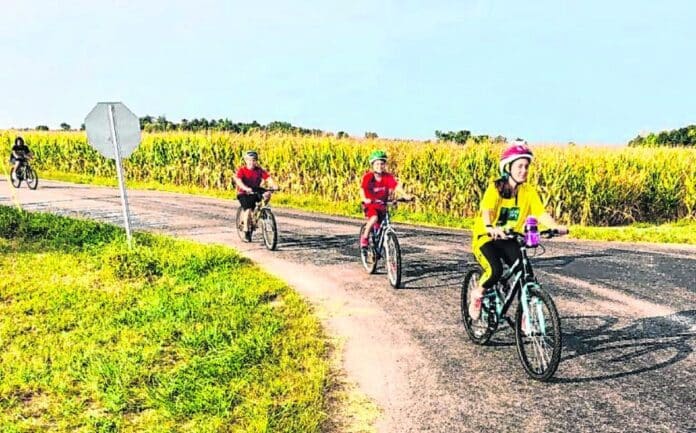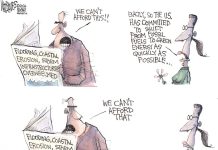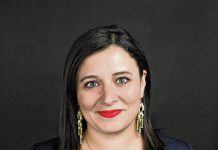
Were it not for the pandemic, Hope Ride founder Paul Ashbrook was expecting a record 2,500 bicyclists for the third Saturday in September.
But with social distancing requirements in place to fend off the coronavirus, the 33rd annual fundraising bicycle ride around the countryside will look and feel different than usual – including when it will occur, how it will operate and how many riders participate.
For starters, the virtual Hope Ride is welcoming bicyclists over a two-week span, Sept. 12 to 26, instead of the traditional single-day event planned that was originally set for Sept. 19.
Normally there would have been activities at the Hope Town Square, stops at local attractions along marked tours, meals, music and bike-riding guides to keep people on track, but not this year.
[sc:text-divider text-divider-title=”Story continues below gallery” ]
Instead, Hope Ride 2020 participants have the flexibility to ride with small, self-organized groups on any of 15 consecutive dates along routes that are being disseminated electronically – and can be followed using GPS technology.
“I wouldn’t rule out that 1,000 people sign up,” Paul Ashbrook said, which would be 400 fewer than last year. “Five hundred to a thousand is realistic.”
After months of following stay-at-home orders, “people are anxious to get out,” said Carol Ashbrook, Paul’s wife and partner in not-for-profit bicycling ventures.
A record 2,300 riders — more than the population of Hope — turned out in 2015, when organizers got 400 to 500 same-day registrants on a gorgeous September Saturday morning, sending volunteers scurrying to secure enough food to feed them all.
This year might have been a carbon copy of 2015, had it not been for the pandemic.
“Cycling is a social distancing type of event,” Paul said, but his flagship ride under normal circumstances places participants — who have traveled from seven states to attend — shoulder to shoulder at food lines and during registration.
That type of interaction is off-limits during this year of the pandemic, forcing the Hope Ride to operate in uncharted territory.
However, parking will still be available at Hauser High School and in downtown Hope, from where bicyclists can span out in loops of various distances and directions:
— 12-mile family friendly tour that goes along nearby Schaefer Lake and Stafford Road.
— A pair of 25-mile flat courses that go past Anderson Falls County Park and Clifty Creek Golf Course.
— 35-mile tour to St. Paul at the Decatur-Shelby County Line, then on to two covered bridges in Rush County.
— 100-mile tour, which combines all of the routes.
Registration this year is $10 for all ages, instead of a $30 fee for adults and $10 for youths in the past. With less expenses this year, the fee reduction was possible.
One thing that hasn’t changed is the Hope Ride’s support to food pantries. As always, the team with the largest number of riders gets to designate $1,000 to a pantry of their choice; second- biggest team, $500; third-biggest team, $250; and to all teams of at least 20 riders, $200 to the pantry of their choice.
The Hope Ride has raised about $775,000 for various charities since 1988, with last year’s event netting about $20,000. The ride has supported a range of causes since its inception, including Hauser High School Dollars for Scholars, Hope Ministerial Association Poor Relief Fund, Hope Summer Playground, youth baseball and softball, area food banks, basketball programs, local 4-H clubs, Boy Scout troops and church missions.
Dollars for Scholars will be selling the sponsorships this year, using those monies to later distribute as college scholarships.
In central Indiana, the Hope Ride has been especially popular among bicyclists from the Indianapolis suburbs of Carmel, Fishers and Zionsville. In contrast to their congested daily navigation close to home, they can “do 100 miles without hitting a stoplight,” Paul said.
Hope Ride sites along the way include the historic Moscow Covered Bridge in Rush County, scenic St. Paul, Mennonite homesteads, historic churches, Simmons Winery/450 North Brewing Co., Red Dog’s Petting Zoo, Anderson Falls Park, old iron bridges, Flat Rock River, windmills, old barns, Possum Glory, Hope’s Bandstand, the Yellow Trail Museum, the Simmons One-Room Schoolhouse and Hartsville – lots of reasons to visit.
“We’ve met people who haven’t missed a Hope Ride,” Paul said. Although previous rides have taken their themes from cows and pop culture, such as "Sgt. Heifer’s Lonely Hearts Club Band" in 2016, this year’s marketing has toned it down due to the seriousness of the pandemic environment. Simply, it’s being marketed as Hope Ride September 2020, albeit with a psychedelic cow logo.
A sister event, the 12th Annual Girlfriend Ride planned for June 15, became the Ashbrooks’ first ride to ever be canceled when it could not meet the governor’s distancing requirements.
But the Schaefer Lake couple was determined to not let that happen a second time with the Hope Ride and in mid-June they committed to a virtual event.
“Every year it’s a new challenge. What bigger challenge than to do it in a pandemic?” Paul said.
The typical Hope Ride depends upon about 200 volunteers to help out at registration, lunch, along the routes, at stops and with cleanup. But it also takes the Ashbrook family’s year-round leadership and involvement. Daughters Abbey, a recent collage graduate, and Annie, an incoming college senior, have also played key roles.
“It’s just part of our life,” Carol said. “It’s a lot of work …”
“But it shows what a couple of people can do,” Paul said, finishing her sentence. Despite the flexibility of being able to ride on any of 15 days, the Ashbrooks are expecting most riders to show up on the third Saturday in September, this year the 19 th , like they always do.
And for the first time, the Ashbrooks will be able to join them on the route – and intend to do just that.
[sc:pullout-title pullout-title=”Paul and Carol Ashbrook” ][sc:pullout-text-begin]
Community service: Organizers of fundraising bicycling events, including the Hope Ride founded in 1988.
Ages: Paul, 58; Carol, 53.
Hometowns: Paul is from Hope, Carol is from nearby St. Louis Crossing.
Education: Both are Hauser High School grads. Paul has a Master’s degree in education from Olivet University near Kankakee, Ill. Carol has a Bachelor of Science degree in business management from Indiana Wesleyan University.
Professions: Paul teaches sixth-grade science at Shelbyville Middle School. Carol is a lease analyst for Newmark, a Cummins supplier based in Columbus.
[sc:pullout-text-end][sc:pullout-title pullout-title=”Sign up to ride” ][sc:pullout-text-begin]
Visit homeride.org to register for the Hope Ride, Sept. 12 to 26, starting in Hope. Cost is $10. T-shirts ($9.95 to $14.95 depending on size) must be ordered when registering, and can be picked up during that span at Willow Leaves of Hope, 326 Jackson St., on Mondays, Tuesdays, Thursdays and Fridays from 11 a.m. to 5 p.m. and 10 a.m. to 2 p.m. Saturdays.
[sc:pullout-text-end]
Retired editor Tom Jekel writes a weekly column that appears each Sunday on The Republic’s Opinion page. Contact him by email through [email protected]




